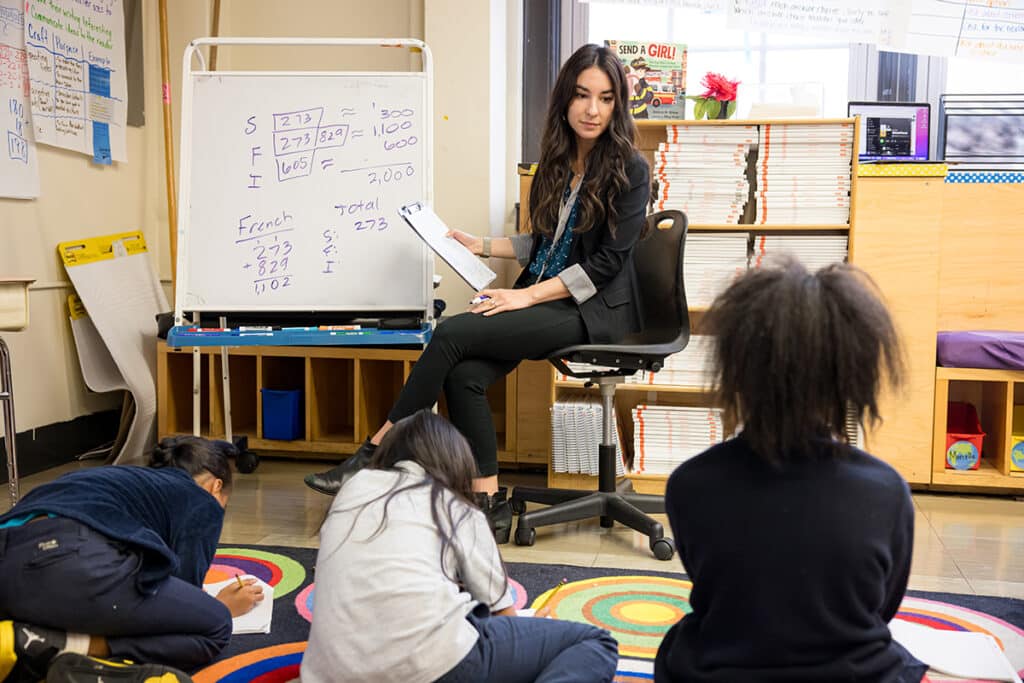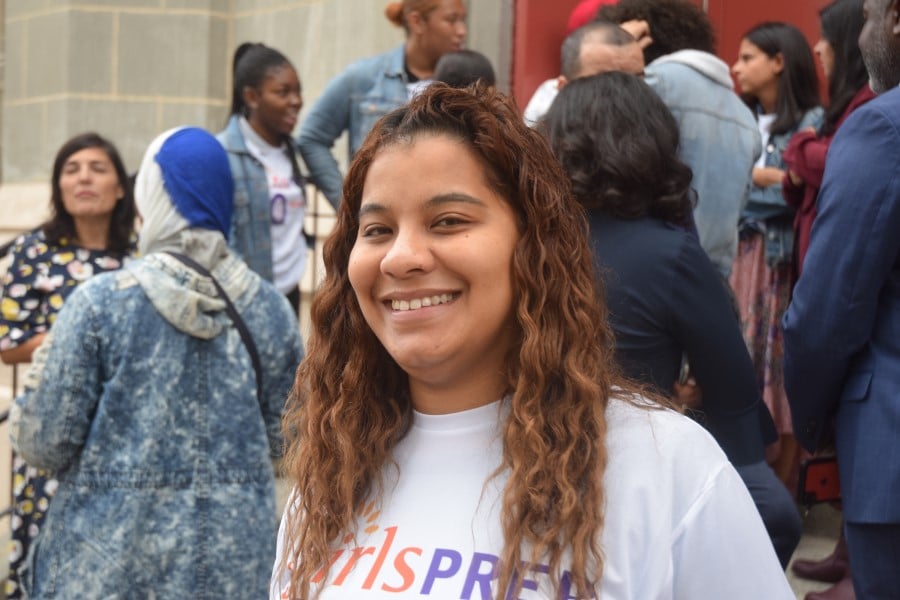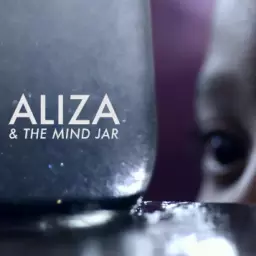Published on Charter School Growth Fund | Nov 6 2020
For public charter school networks across the country, the return to in-person instruction has been going well, and evidence continues to suggest that schools have seen very low COVID-19 transmission rates.
But even the best laid plans cannot reduce risk to zero. When (not if) a COVID case affects a school, having a clear plan for communication and — if needed — reclosure can reduce the burden on leaders and the school community.
“To act in the interest of health and safety means to move fast,” emphasized Andrew Stephenson, associate chief operating officer at Uncommon Schools. “Talking about these situations head on and telling people what we are going to do is really important.”
Aaron Daly, chief operating officer of Brooklyn Laboratory Charter Schools, knows this from lived experience. When one of Brooklyn Lab’s students tested positive for COVID in August, Daly reflected, “We could have had an easier road if someone could have seen into the future.” Planning ahead for the reality of reclosure “took a lot of weight and burden off our shoulders” and gave leaders and staff the confidence and ability to quickly do what’s best.
Here’s how great public charter schools are preparing for reclosure in advance so they can act to protect their students and staff when needed.
“In March, when those first cases popped up, leaders did not know what to do. We knew we needed to give direction,” said Stephenson.
Uncommon reserved 35 pages in its reopening health and safety procedures document for reclosure planning. The plan attempts to balance clarity of decision-making and action with the knowledge that every incident of potential viral transmission will be unique. Shared Stephenson, “We could not be so prescriptive that we took away people’s ability to make decisions.”
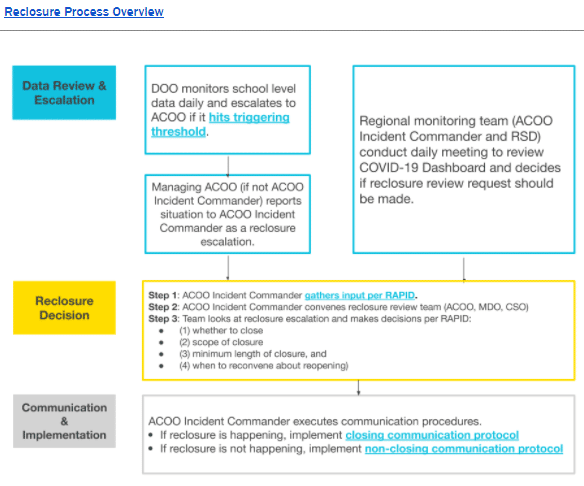
A Quick Look at Uncommon’s Reclosure Process — see more here
In addition to tracking confirmed COVID cases within the immediate school community, some schools are monitoring the transmission rate in their broader communities or even the number of staff and students with qualifying symptoms to make decisions on when and how to act.
“We wanted a leading indicator if testing availability and results continue to lag in some regions,” shared Stephenson. “We also wanted to be able to tell our leaders and our staff how we are going above and beyond to protect their health and safety — and qualifying symptoms might allow us to react sooner.”
Every Uncommon school has its own tracker for monitoring these data points, as well as a summary dashboard that rolls up data from the region.

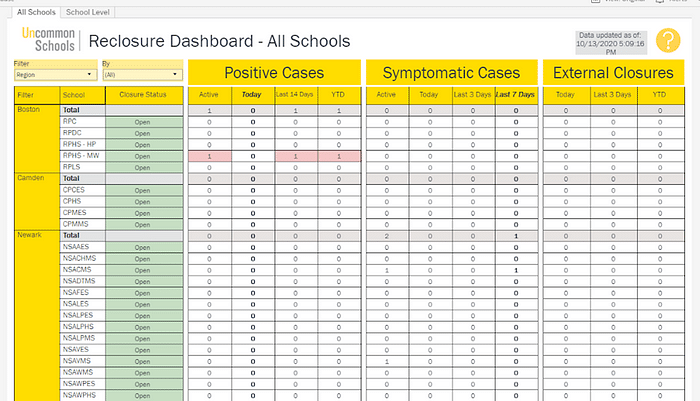
Schools should follow any district or state requirements for reclosure (see examples from New York City and New Orleans). When clear guidelines are not available, however, some schools have supplemented local guidance or determined their own criteria for quarantine or reclosure escalation.
For example, Zeta Charter Schools outlined 13 scenarios and its planned response protocol for each, including when a sibling, parent, or spouse of a school member has symptoms or is diagnosed with COVID.
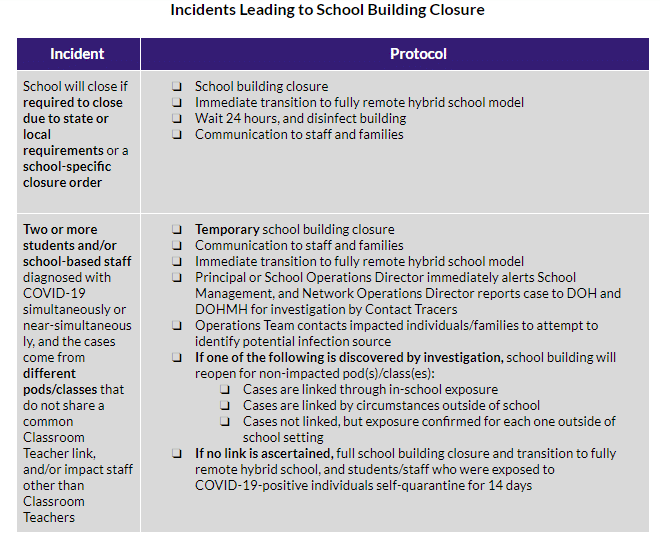
An example of Zeta’s COVID-19 quarantine and closure charts — see more here
Uncommon Schools included both accumulated school-wide qualifying symptoms and school staffing limitations in its criteria. The goal is to get ahead of any scenario and provide reassurance to school leaders and staff.
These scenarios don’t force a school reclosure automatically but escalate the situation into a clear decision-making and communication protocol.
Public Prep Schools, for example, outlined an 11-step process from identifying a positive case to working with the local health authority, communicating with stakeholders, and arranging staff coverage if needed.
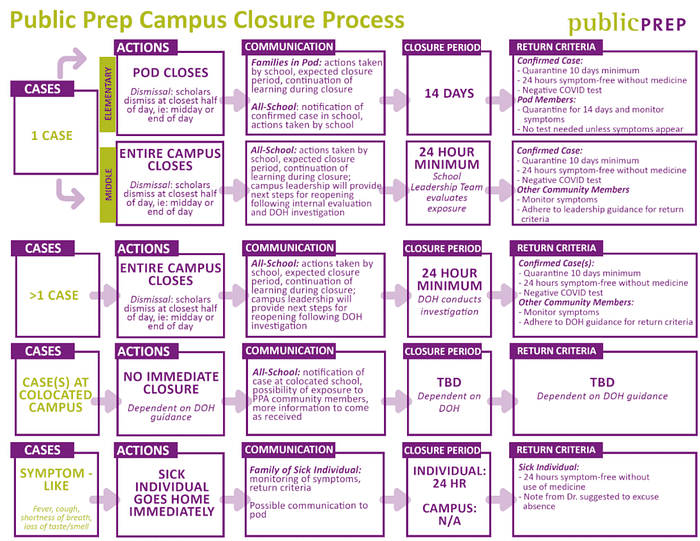
Example of Public Prep’s logic path for COVID-19 response — see more here
With the extensive amount of information coming in and changing daily, we needed to define a logical path based on the myriad of scenarios we will face when a member of our community tests positive or has been in close contact with a positive case.
Uncommon’s protocol includes guidelines for determining the scope of any reclosure (classroom, school, region), the minimum length of closure, and when to consider reopening. It relies on a regional incident commander — someone well-trained in the protocol — to shepherd the process and engage with the local department of health.
Uncommon also set a two-hour timeline for reaching a decision on reclosure once an escalation threshold is reached. This is designed to limit internal bottlenecks, not force a decision on whether to close within 120 minutes.
“The decision could be that we need to wait and connect with the department of health to learn more,” Stephenson clarified. “But we have some situations where it would be incredibly clear what to do, and we did not want to abdicate our decision-making.”
After its first (and only) positive COVID case in August, Brooklyn Laboratory Charter Schools created a communications toolkit, including call and email scripts for a range of stakeholders (families, school staff, and district leaders) on topics such as positive cases and closures, instructional model changes, and more nuanced issues like a student being sent to the isolation room, or welcoming a staff member back from quarantine.
Instead taking five hours to get the right communication out, the process can take 30 minutes.
Daly quarterbacks communication, sending out notices to family and general staff, as well as making personal calls to anyone who comes into direct contact with a suspected positive case. Principals manage communication to their school staff.
Clarity and transparency should be the guiding principles for any communication, Daly added. “We don’t want to sugarcoat anything. We need to be as factual as possible. But we don’t want to be alarmist either. Any communication needs to have a calm, clear tone.”
While the templates account for many situations, new scenarios always will require tweaking. For example, New York City announced the reclosure of schools in nine zip codes in response to localized outbreaks in October.
“That was new, and we didn’t have a template for that, so the communication always needs to be adjusted because the situation is fluid,” Daly said.
Here are more communication templates from Public Prep and Uncommon.
All schools will benefit from clear plans on how they will respond to positive cases and make decisions about reclosure, particularly because any such situation will increase anxiety among the community.
Having a communications toolkit and a response plan in place has taken “a lot of weight and burden off our shoulders,” said Brooklyn Lab’s Daly.
